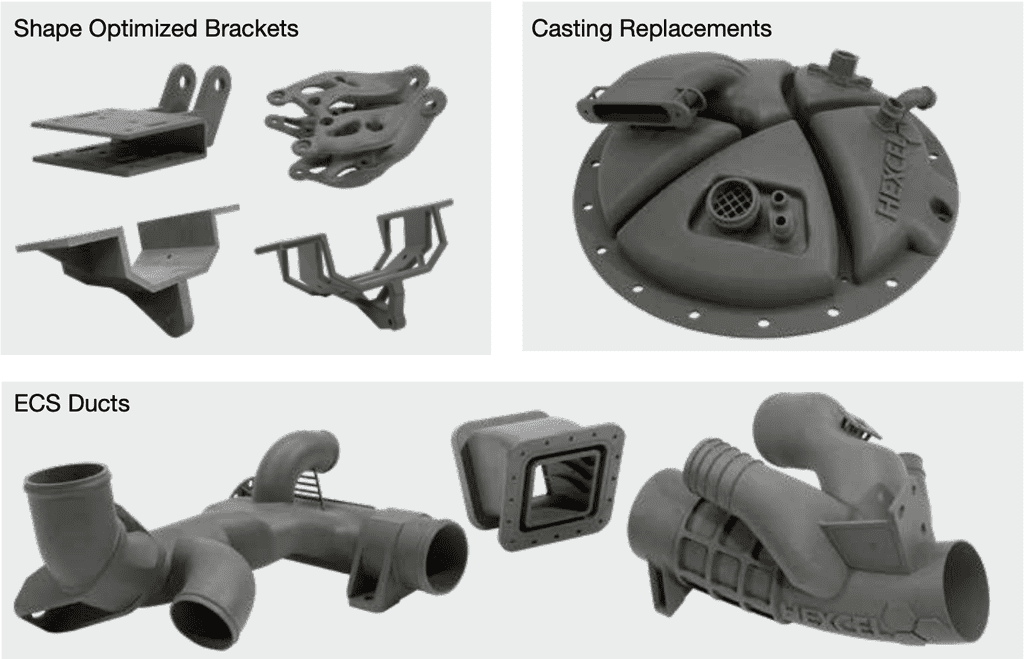Advanced composite materials company Hexcel has launched a new electrically-conductive polymer-based carbon fiber composite for 3D printing – HexPEKK Polymer.
The firm’s new thermoplastic, HexPEKK EM, has been custom-made to meet the static electricity management, electromagnetic (EM) shielding, and radiation absorption needs of advanced aircraft applications. By integrating EM qualities directly into 3D printed parts, Hexcel’s material could enable users to cut out costly post-processing steps, and deliver “flight-ready” components from the outset.
“The introduction of this advanced additive manufacturing material will enable the fabrication of extremely complex aerostructures with unparalleled structural and electrical functionality,” said Lawrence Varholak, Vice President of Additive Manufacturing at Hexcel. “It significantly reduces weight and cost while providing unlimited design flexibility.”
Hexcel’s growing portfolio of 3D printing materials
Having been founded in 1948, Hexcel is an established producer of materials, not just for the 3D printing industry, but the wider industrial manufacturing sector as well. In addition to its product portfolio, the company has vested interests in a variety of sectors, including the flight, energy generation and transportation industries.
Hexcel’s current product lineup includes a range of carbon fibers, fabrics, adhesives and tooling materials, but those within 3D printing will most likely recognise its proprietary line of HexPEKK thermoplastics. The polymer range has been optimized for fabricating aerospace parts, and has even fulfilled the interior aircraft smoke and toxicity requirements (UL VO, OHS) for end-use within the industry.
Hexcel’s additive aerospace focus can be traced back to 2016, when it opened a new research center in Duxford, UK, with the aim of developing new composite materials for the aviation and industrial markets. A year later, the firm went a step further, and acquired Oxford Performance Materials (OPM), a known producer of high-performance thermoplastic and carbon fiber-reinforced 3D printed parts.
After the acquisition, Scott DeFelice, CEO of OPM, said that its focus “remained on the applications of PEKK” and that the firm had “some exciting new materials in development.” Hexcel subsequently reaffirmed its commitment to developing new PEKK aviation materials, by gaining 3D printed part approval from multinational aeronautical corporation Boeing.
The accreditation was awarded directly to Hexcel’s HexPEKK polymers, and this allowed them to be used within the fabrication of brackets, environmental control system ducts, and castings. Following the launch of the latest edition of HexPEKK, the company is now aiming to address an even broader set of applications within the aviation sector.

HexPEKK EM’s lofty aerospace credentials
At present, non-EM enabled printing materials require a conductive coating to be applied, in order for them to possess the required qualities for use within the aerospace industry. Conductivity is essential within aviation applications, as it enables parts to effectively manage electromagnetic interference and absorb radiation.
Hexcel’s new PEKK material has integrated EM properties that forgo the need for such expensive and time-consuming post-processing tasks, which potentially makes it well-suited to printing a range of aerospace parts. The polymer was developed using the firm’s industry-qualified HexAM process, meaning that it has already demonstrated a high-level of performance in terms of the sustainability, operating temperature, and chemical resistance.
“The management of static electricity dissipation, electromagnetic interference, and radiation absorption is extremely important in the design of all air vehicles.”
The company’s self-proclaimed “industry-leading” material is targeted at producing components for end-use within commercial airplanes, military aircraft, helicopters and UAVs. According to Hexcel, this makes HexPEKK EM ideal for reducing the weight and cost of relevant parts such as air inlets, electronic enclosures, and cockpit structures.
What’s more, the inherent design flexibility of 3D printing could encourage similar aviation objects to be re-designed in a more cost and performance-efficient way. Moving forwards, the firm has committed to continue developing its patented HexAM process, to “fundamentally improve the way the world’s aircraft components are manufactured.”


